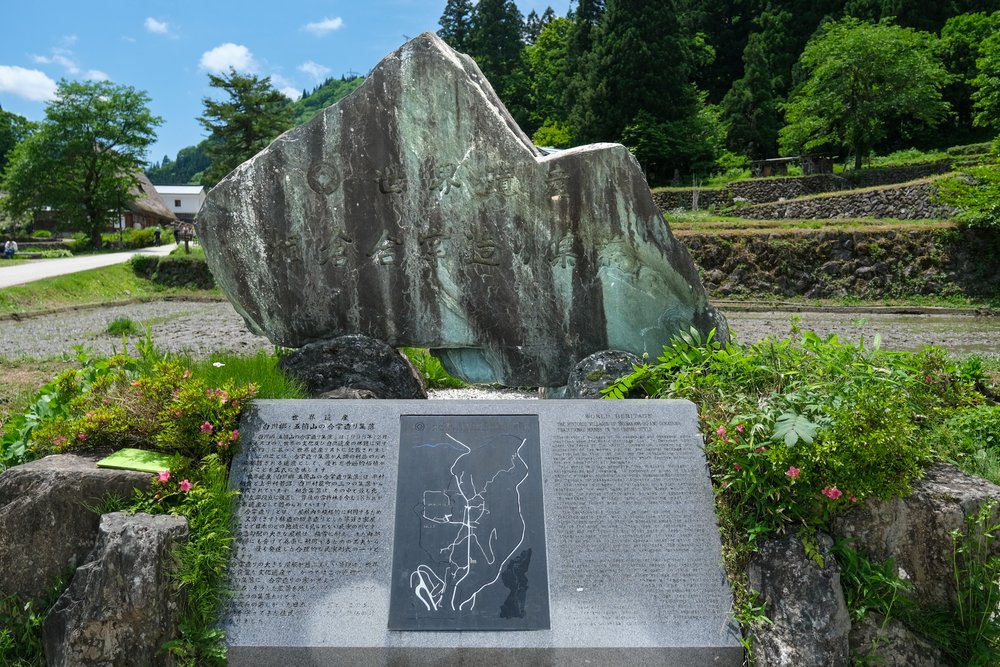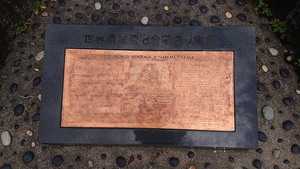Shirakawa-go and Gokayama

The Historic Villages of Shirakawa-go and Gokayama are traditional Japanese settlements.
The three villages lie in isolated valleys, with the inhabitants growing mulberry trees and rearing silkworms. Their characteristic farmhouses, Gassho-zukuri, have triangular-shaped roofs so snow can slide off easily. They are also large enough to store silk products.
Community Perspective: the best time to visit is in winter, with the thick layers of snow on the roofs. From the 3 included villages most reviewers visited Ogimachi in Shirakawa-go, which sees a lot of tourists in general. Hubert describes Ainokura, where he also stayed the night.
Map of Shirakawa-go and Gokayama
Community Reviews
Hubert

The title of this WHS could be a little misleading at first glance, as Shirakawa-go and Gokoyama denote the regions, the names of the three inscribed villages are Ogimachi, Suganuma, and Ainokura. For the largest village, Ogimachi and Shirakawa-go seem to be used synonymously, probably because it is the most popular tourist attraction in the region.
When I was planning the itinerary for my trip to Japan in September 2019, one of my first decisions was to stay a night in one of the traditional Gasshō-style houses. I actually wanted to book an accommodation in Ogimachi, but it ended in one night in Ainokura.
The three WHS villages are located in the narrow valley of the Shōgawa River, once a remote area, today fully developed for tourism and accessible by bus or car. I arrived in Ainokura in the afternoon by bus from Takaoka. Ainokura (photo) is the northernmost of the three villages, about 20 of the Gasshō-zukuri houses have been preserved there. It is a picturesque location: the thatched houses between small rice fields, surrounded by forests and high mountains. However, this applies to all of the inscribed villages.
Gasshō means "hands folded in prayer" and alludes to the steep roof, which makes the snow easier to slip off and the construction better withstands the harsh weather in winter. This roof construction also has other advantages: it provides a lot of space in the attic. The Gasshō houses usually have three or four floors, the residents lived and worked on the lower floors, the attic was used to raise silkworms. The heat rose from an open fire pit on the first floor up to the roof, keeping the silkworms and their cocoons warm. The Yusuke House is open to the public, it shows an exhibition on sericulture, and you can see the historic interior and the roof construction of a traditional farm house. No nails are used for the roof, the massive beams are only tied together with ropes and secured with wooden pins.
Ainokura has an authentic atmosphere. Most of the Gasshō houses seem to be inhabited, and there are only a few modern additions. I really enjoyed my visit to Ainokura, the stay at Goyoma Guest House and the delicious meals there.
The next morning, I continued to Ogimachi with a stopover in Suganuma. An hour to the next bus was enough time to explore the smallest of the three villages. It is beautifully located in the middle of a river bend, surrounded by rice fields. Suganuma has only nine traditional houses, but each of which is a shop, a café or a museum.
Finally, Ogimachi, the largest of the three villages and by far the most popular. There are about 60 Gasshō houses in Ogimachi, but also many modern buildings, especially along the main street with many shops and restaurants. Some of the traditional houses are open to visitors. I would recommend the Nagase House, with five floors it is the largest Gasshō in Ogimachi. A must-do is to walk to the viewpoint at the former location of the Ogimachi castle, from there you have a wonderful panoramic view of the village.
Stay in a Gasshō house
I booked my accommodation via Japanese Guest Houses. There are other platforms, e.g. the Shirakawa-go Tourist Association. Some of the ryokans have their own website, but mostly only in Japanese. I actually planned to stay in Ogimachi, but in September they did not accept single bookings. Instead, JGH offered me a stay in Ainokura and I chose the Goyomon Ryokan. A good choice. Goyomon has three traditional-style guest rooms, I paid 9200 Yen, dinner and breakfast were included.
Getting there and getting around
Most visitors take the highway bus from Takayama or Kanazawa to Shirakawa-go. However, I had to go to Ainokura in the north of the Shōgawa Valley, so I chose the route via Takaoka. And that turned out to be very convenient. Trains from Kyoto to Takaoka are covered with the JR Pass. A bus line of the Kaetsuno Company connects Shin-Takaoka with all three WHS locations. The line is called World Heritage Bus, rightly so. You can buy tickets from the bus driver or from the tourist information in the train station, pre-booking is not necessary. It tooks one hour from Shin-Takaoka to Ainokura, and 50 minutes from Ainokura to Ogimachi.
Michael Turtle

I loved Shirakawa-go and had a good length of time to explore it. Many people come in just for the day and walk around and go to the shops. I was lucky enough to do a home stay and spent the night in one the houses with a family. It was fantastic to not only see one of the houses from the inside, but also experience what it would be like to live in one.
I was here during winter and the snow and the roofs is so beautiful. I imagine the town has a really different look for each season - you could go four times in a year and see such different views.
Read more from Michael Turtle here.
Frederik Dawson

Deep in the scenic valley of Japan Alps, but easily accessible by highway, was the beautiful village of Shirakawa-Go, a wonderland of beautiful landscape with traditional farmhouses built in the style called Gassho-Zukuri, a steeply thatch roof house to prevent snow accumulation. The houses were really unique and different with mainstream Japanese architecture which cannot be found in other region of this country.
Since the farmhouses were designed for winter, I decided to see the village in the best time of the year, February when the snow was heaviest, and my decision was correct, the whole village was liked a fantasyland with the unique Gassho-Zukuri roofs emerged from the white sea of snow. The houses were really big and beautiful, and the snow made them looked more unbelievable to be existed.
The village was well prepared for tourism, locals made many cute snowmen for photo spot while in the souvenir shops were packed with hundreds of gifts made in the shape of Gassho-Zukuri. After the village I went to the famous viewpoint to see the postcard view of the village, and the view was just amazing and should be seen by everyone. Then I continued my trip to Shirakawa-Go-no-Yu, the traditional hot spring bath hall, to sample the experience, the hot spring and the river view from outdoor bath were really good.
I really enjoyed my trip to Shirakawa-Go; the village in winter was exceeding my expectation and was one of the highlights of Japan apart from Kyoto which was always my highlight of every Japan trips. Actually, judging from other reviews, the place seems to be great for every season and from my opinion, another great WHS that deserved to be listed and seen.
John booth

I too visited Ogimachi village in Shirakawa-go by taking the bus from Takayama. While Ogimachi was quite large and had many gassho houses, some of which I went inside to inspect, it was also very crowded and touristy.
From Ogimachi there are other buses that travel to Takaoka, and on the way stop at the other two villages, Ainokura and Suganuma in Gokayama, that form part of this WHS. They are equally authentic, but are much smaller and attract far fewer visitors than Ogimachi.
Maggie Huang
The first impression that I had with Shirakawa-gou was from a picture I saw on the internet. It feeled just too beautiful to be real. Then I did a lot of research online about this picturesque place; and actually went visiting in November 2005.
Its purity and tranquility can really ease a person's mind. You can also enjoy different scenery when visiting in different seasons.
I will go visit again and again if I had time; and really soak in the true beauty of Shiragawa-gou.
C H Ho
Hong Kong, China - 01-May-05 -
If I can only select one farming village to go in Japan, I must select Shokawa-village. I went there in 1999 but taking 2.5 hours bus from Takayama. I arrived there at night and stayed in a homestead. I could see nothing inside the village at night. In the next morning, when I opened the Japanese window-door from my room. I see many Gassho-zukuri houses just outside! The houses lies inside the valley of the Japan Alps. It likes a picture more than a village. It might be more convenience to visit the villages as a highway was opened from Nagoya to Toyama.
Els Slots

Within the valley, I visited the village of Ogimachi, a two-hour bus ride from Takayama in the middle of the Japanese Alps. There quite a lot of the Gassho-zukuri houses can still be found together.
Although it was packed with Japanese tourists, I liked it a lot. The environment is totally unlike the stereotype Japan. In a way, the scene remembered me of Bhutan, where in the green valleys also this kind of big houses annex farms still stand (however without the characteristic thatched roofs).
Community Rating
- : Eva Kisgyorgy Vernon Prieto Longdutch Dhhtravel Mihai Dascalu Danabach Deffra Errol Neo Scubarrie Elena Y
- : Cutecid Xiquinho Silva Chenboada Xiong Wei Sncjob Kasileigh NoahFranc
- : Riccardo Quaranta Tamara Ratz Joyce van Soest Zoë Sheng ReallyDeepThoughts Mike Allnamesused Kbtwhs Frederik Dawson Jon Bauer Naim Y Miguel Marquez TaiTT
- : Patphilly Tingmelvin Philipp Peterer Philipp Leu Mepilokisazt Pchxiao Hubert Luke LOU Reisedachs Caspar Dechmann Els Slots
- : Randi Thomsen Alexander Lehmann Nan Alexander Parsons Shandos Cleaver Ralf Regele Jon Opol Astraftis Nolan B. Ammon Watkins Svein Elias
- : Kurt Lauer Bill Maurmann
- : Wojciech Fedoruk
Site Info
Site History
1995 Inscribed
Site Links
Unesco Website
Official Website
Related
In the News
Connections
The site has 10 connections
Art and Architecture
Ecology
Human Activity
Religion and Belief
Timeline
Trivia
WHS on Other Lists
Visitors
160 Community Members have visited.
The Plaque
 (external source)
(external source) (photo by Hubert)
(photo by Hubert)